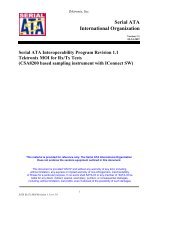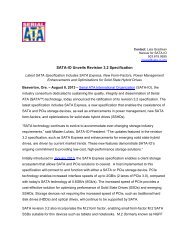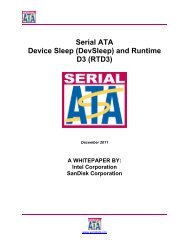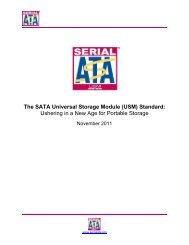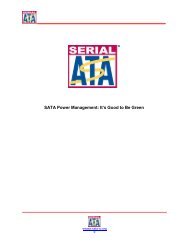1.0 - SATA-IO
1.0 - SATA-IO
1.0 - SATA-IO
You also want an ePaper? Increase the reach of your titles
YUMPU automatically turns print PDFs into web optimized ePapers that Google loves.
Appendix B2: Calibration of Test Setup AC Common Mode.<br />
Purpose: Calibration of the AC Common Mode insertion loss for TSG-04 measurements.<br />
Last Modification: October 14, 2009<br />
Discussion: The ratio of a 100 mV reference to the measured signal on the BERTScope is the inverse of<br />
the insertion loss. The measured data are then scaled with this factor to obtain the actual values. This<br />
calibration removes the effect of AC common mode insertion loss from the test. The reference plane for the<br />
calibrations is the SMA interface where the <strong>SATA</strong> receptacle connects to the test setup.<br />
Resource Requirements and Calibration Setup as shown in Appendix E: Except the BERTScope clock<br />
output is connected to the BERTScope clock input using the short SMA Male to SMA Male Cable.<br />
Connect the BERTScope Data Output + and Data Output - ports to the DUT Input ports of the <strong>SATA</strong> Tee<br />
(or to the short matched pair of SMA Male to Male Cables that connects to the CR 12500A Data Input<br />
ports if the <strong>SATA</strong> Tee is not used). Connect the Data Output + and - ports of the CR 12500A to the<br />
symmetrical input ports of the power combiner using the matched pair of cables. Connect the output of the<br />
power combiner to the low pass filter and connect the other end of the low pass filter to the Data Input +<br />
port on the BERTScope. Terminate the Data Input – port on the BERTScope with the 50 ohms termination.<br />
Calibration Procedure:<br />
1. The common mode insertion loss can be calibrated by simply applying a MFTP pattern from<br />
the BERTScope Data Outputs with 100 mV of common mode sinusoidal interference turned<br />
on to test setup; namely through the matched pair of short SMA Male to SMA Male cables<br />
combined with the CR 12500A Data Input to Data Output paths ways, power combiner and<br />
low pass filter. The ratio of the 100 mV to the measured calibration signal on the BERTScope<br />
is the inverse of the insertion loss. The measured data are then scaled with this factor to obtain<br />
the actual values. All calibration screen shots need to be saved. This is done by clicking on<br />
“Print” and select “Print to file” then create a unique file name for each calibration data<br />
including the serial number of the equipment.<br />
Observable Results: Record the ratio of the 100 mV reference to the measured signal. Measured data are<br />
then scaled with this factor to obtain the actual values in TSG-04.<br />
Appendix B3: Calibration of Test Setup De-embedding.<br />
Purpose: Measurement of the test setup insertion loss for de-embedding to the reference plane at the SMA<br />
side of the <strong>SATA</strong> receptacle. This applies to all TSG measurements except TSG-04 which is a common<br />
mode test.<br />
Last Modification: Mach 29, 2010<br />
Discussion: The BERTScope is used to generate and capture the step response of the path through cables<br />
and other components to the BERTScope detector input. Fast Fourier Transformation (FFT) is applied to<br />
the step response, which is then subtracted from the FFT of a reference step response to get the insertion<br />
loss of the path. The BERTScope FIR Explorer software then calculates an FIR filter then compensates for<br />
the insertion loss. The reference plane for the calibrations is the SMA interface where the <strong>SATA</strong> receptacle<br />
connects to the test setup. This FIR filter is applied during TSG measurements, except TSG04, which is a<br />
common mode test.<br />
Resource Requirements and Calibration Setup as shown in Appendix E: Except the BERTScope clock<br />
output is connected to the BERTScope clock input using the short SMA Male to SMA Male Cable.<br />
Initially connect the BERTScope Data Outputs to the Data Inputs of the entire test setup; namely through<br />
the matched pair of short SMA Male to SMA Male cables connected via a pair of 50 ohms SMA female-tofemale<br />
adapters to the reference plane where the <strong>SATA</strong> receptacle connects. Later the short matched pair of<br />
Data Output cables will be connected directly to the BERTScope Data Inputs for a reference measurement.<br />
Serial ATA Logo Group 38 MOI Revision 1.3 Version <strong>1.0</strong> using BERTScope




